Cultural Safety in Healthcare: Mind Map and Essay on Cultural Values
VerifiedAdded on 2021/04/24
|6
|1622
|59
Essay
AI Summary
This essay and mind map explores the concept of cultural safety in healthcare, emphasizing the profound impact of culture on individuals' perceptions, actions, and interactions. The author, drawing from their Hindu background, highlights how cultural values shape their approach to patient care, emphasizing the importance of empathy, non-violence, and respect for all life forms. The essay delves into how these values influence ethical considerations, such as attitudes towards abortion and organ donation, as well as the importance of providing equitable and accessible healthcare. It stresses the need for practitioners to understand and address cultural differences, promote patient well-being, and foster a sense of community, respect for the environment, and sustainability. Ultimately, the essay underscores the role of culture in shaping a practitioner's character and their commitment to serving a multicultural society with compassion and understanding.
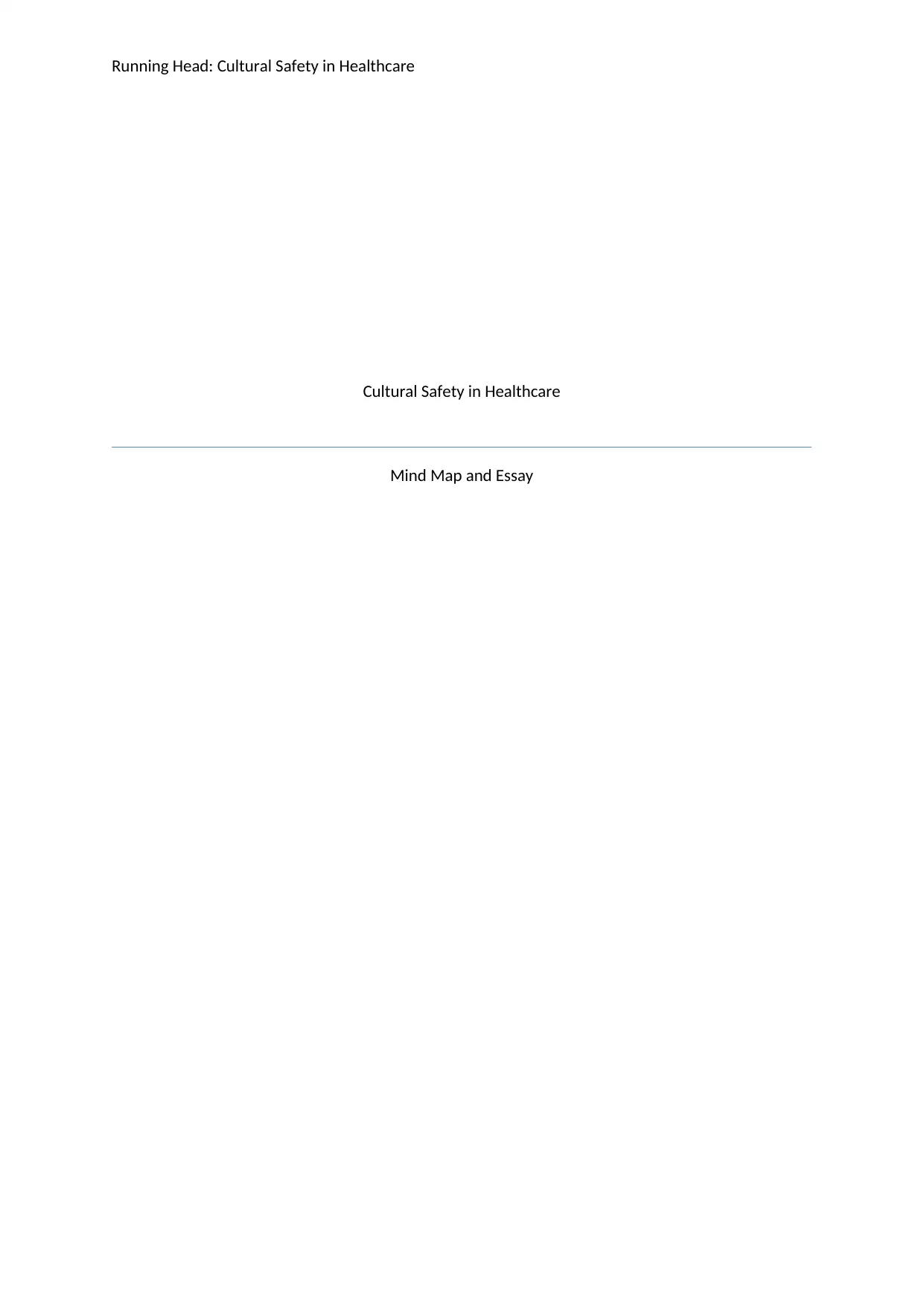
Running Head: Cultural Safety in Healthcare
Cultural Safety in Healthcare
Mind Map and Essay
Cultural Safety in Healthcare
Mind Map and Essay
Paraphrase This Document
Need a fresh take? Get an instant paraphrase of this document with our AI Paraphraser
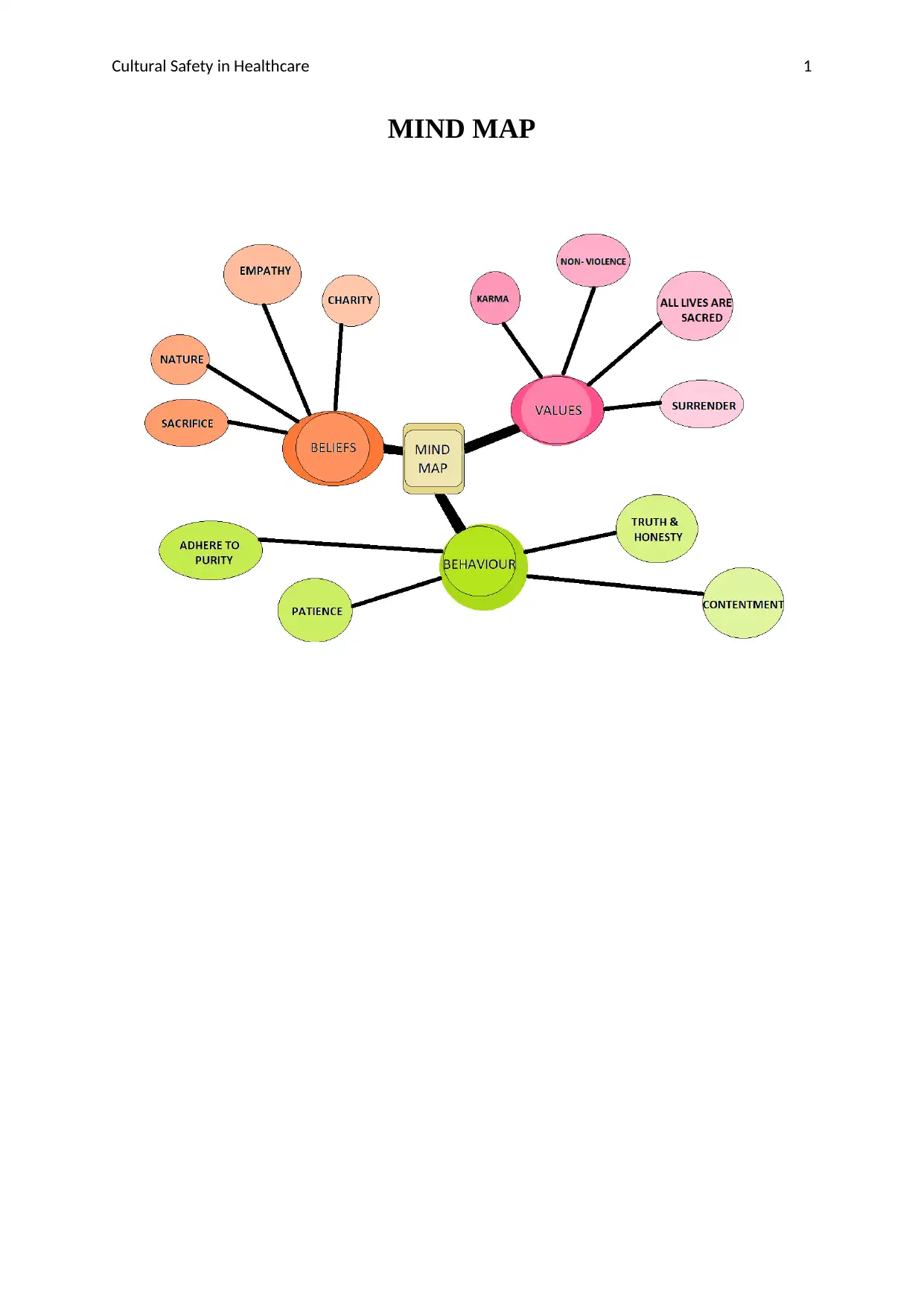
Cultural Safety in Healthcare 1
MIND MAP
MIND MAP
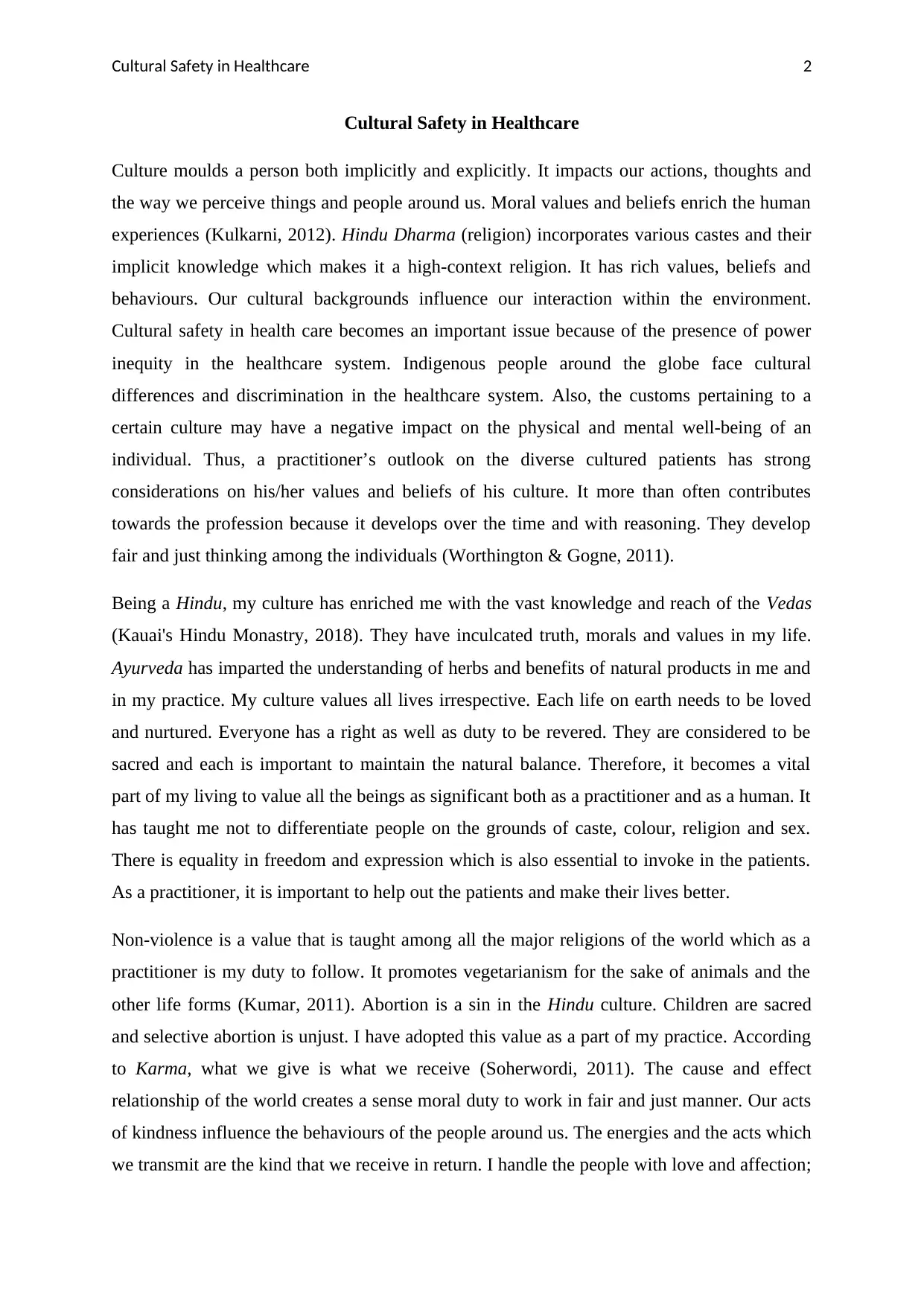
Cultural Safety in Healthcare 2
Cultural Safety in Healthcare
Culture moulds a person both implicitly and explicitly. It impacts our actions, thoughts and
the way we perceive things and people around us. Moral values and beliefs enrich the human
experiences (Kulkarni, 2012). Hindu Dharma (religion) incorporates various castes and their
implicit knowledge which makes it a high-context religion. It has rich values, beliefs and
behaviours. Our cultural backgrounds influence our interaction within the environment.
Cultural safety in health care becomes an important issue because of the presence of power
inequity in the healthcare system. Indigenous people around the globe face cultural
differences and discrimination in the healthcare system. Also, the customs pertaining to a
certain culture may have a negative impact on the physical and mental well-being of an
individual. Thus, a practitioner’s outlook on the diverse cultured patients has strong
considerations on his/her values and beliefs of his culture. It more than often contributes
towards the profession because it develops over the time and with reasoning. They develop
fair and just thinking among the individuals (Worthington & Gogne, 2011).
Being a Hindu, my culture has enriched me with the vast knowledge and reach of the Vedas
(Kauai's Hindu Monastry, 2018). They have inculcated truth, morals and values in my life.
Ayurveda has imparted the understanding of herbs and benefits of natural products in me and
in my practice. My culture values all lives irrespective. Each life on earth needs to be loved
and nurtured. Everyone has a right as well as duty to be revered. They are considered to be
sacred and each is important to maintain the natural balance. Therefore, it becomes a vital
part of my living to value all the beings as significant both as a practitioner and as a human. It
has taught me not to differentiate people on the grounds of caste, colour, religion and sex.
There is equality in freedom and expression which is also essential to invoke in the patients.
As a practitioner, it is important to help out the patients and make their lives better.
Non-violence is a value that is taught among all the major religions of the world which as a
practitioner is my duty to follow. It promotes vegetarianism for the sake of animals and the
other life forms (Kumar, 2011). Abortion is a sin in the Hindu culture. Children are sacred
and selective abortion is unjust. I have adopted this value as a part of my practice. According
to Karma, what we give is what we receive (Soherwordi, 2011). The cause and effect
relationship of the world creates a sense moral duty to work in fair and just manner. Our acts
of kindness influence the behaviours of the people around us. The energies and the acts which
we transmit are the kind that we receive in return. I handle the people with love and affection;
Cultural Safety in Healthcare
Culture moulds a person both implicitly and explicitly. It impacts our actions, thoughts and
the way we perceive things and people around us. Moral values and beliefs enrich the human
experiences (Kulkarni, 2012). Hindu Dharma (religion) incorporates various castes and their
implicit knowledge which makes it a high-context religion. It has rich values, beliefs and
behaviours. Our cultural backgrounds influence our interaction within the environment.
Cultural safety in health care becomes an important issue because of the presence of power
inequity in the healthcare system. Indigenous people around the globe face cultural
differences and discrimination in the healthcare system. Also, the customs pertaining to a
certain culture may have a negative impact on the physical and mental well-being of an
individual. Thus, a practitioner’s outlook on the diverse cultured patients has strong
considerations on his/her values and beliefs of his culture. It more than often contributes
towards the profession because it develops over the time and with reasoning. They develop
fair and just thinking among the individuals (Worthington & Gogne, 2011).
Being a Hindu, my culture has enriched me with the vast knowledge and reach of the Vedas
(Kauai's Hindu Monastry, 2018). They have inculcated truth, morals and values in my life.
Ayurveda has imparted the understanding of herbs and benefits of natural products in me and
in my practice. My culture values all lives irrespective. Each life on earth needs to be loved
and nurtured. Everyone has a right as well as duty to be revered. They are considered to be
sacred and each is important to maintain the natural balance. Therefore, it becomes a vital
part of my living to value all the beings as significant both as a practitioner and as a human. It
has taught me not to differentiate people on the grounds of caste, colour, religion and sex.
There is equality in freedom and expression which is also essential to invoke in the patients.
As a practitioner, it is important to help out the patients and make their lives better.
Non-violence is a value that is taught among all the major religions of the world which as a
practitioner is my duty to follow. It promotes vegetarianism for the sake of animals and the
other life forms (Kumar, 2011). Abortion is a sin in the Hindu culture. Children are sacred
and selective abortion is unjust. I have adopted this value as a part of my practice. According
to Karma, what we give is what we receive (Soherwordi, 2011). The cause and effect
relationship of the world creates a sense moral duty to work in fair and just manner. Our acts
of kindness influence the behaviours of the people around us. The energies and the acts which
we transmit are the kind that we receive in return. I handle the people with love and affection;
⊘ This is a preview!⊘
Do you want full access?
Subscribe today to unlock all pages.

Trusted by 1+ million students worldwide
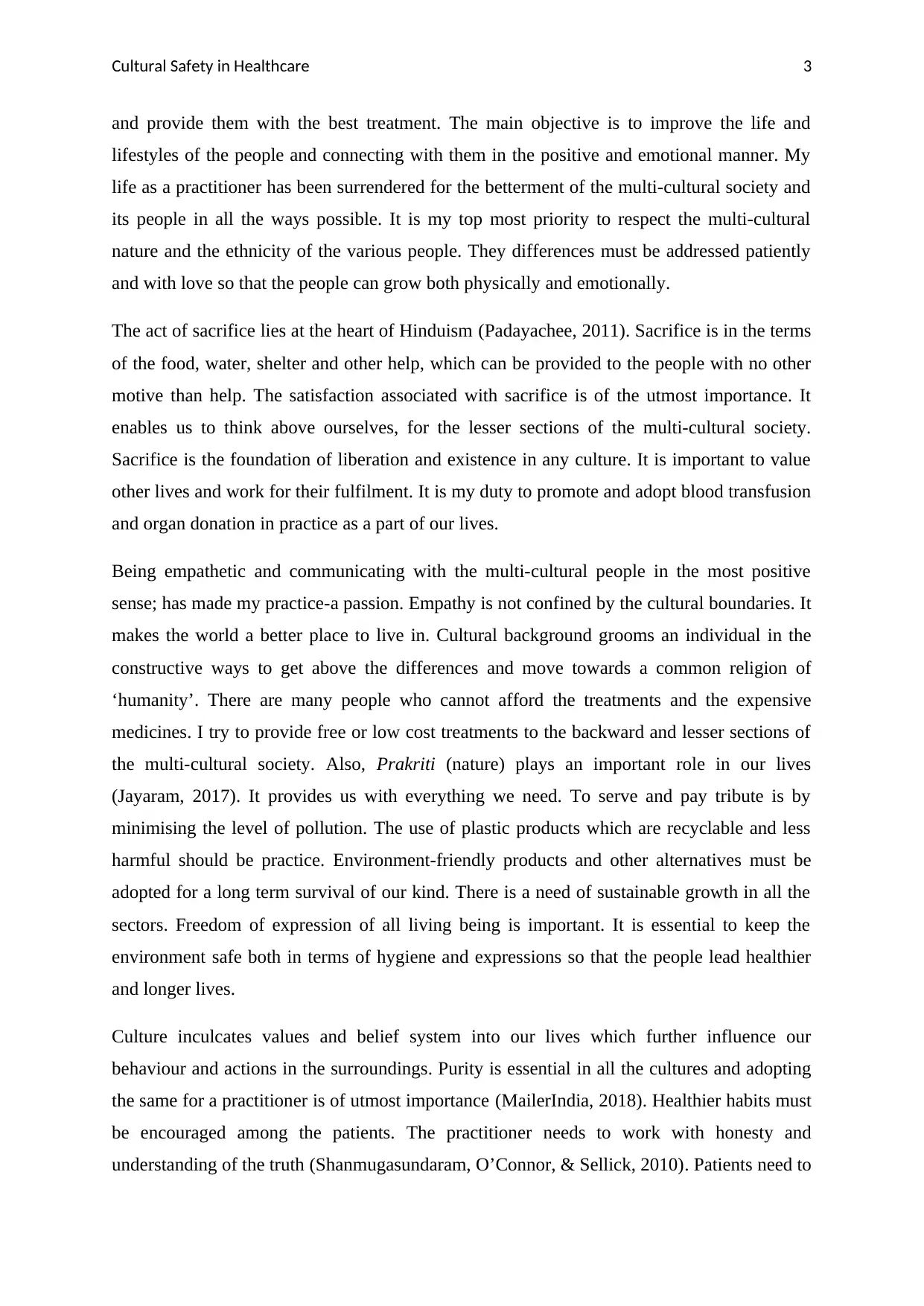
Cultural Safety in Healthcare 3
and provide them with the best treatment. The main objective is to improve the life and
lifestyles of the people and connecting with them in the positive and emotional manner. My
life as a practitioner has been surrendered for the betterment of the multi-cultural society and
its people in all the ways possible. It is my top most priority to respect the multi-cultural
nature and the ethnicity of the various people. They differences must be addressed patiently
and with love so that the people can grow both physically and emotionally.
The act of sacrifice lies at the heart of Hinduism (Padayachee, 2011). Sacrifice is in the terms
of the food, water, shelter and other help, which can be provided to the people with no other
motive than help. The satisfaction associated with sacrifice is of the utmost importance. It
enables us to think above ourselves, for the lesser sections of the multi-cultural society.
Sacrifice is the foundation of liberation and existence in any culture. It is important to value
other lives and work for their fulfilment. It is my duty to promote and adopt blood transfusion
and organ donation in practice as a part of our lives.
Being empathetic and communicating with the multi-cultural people in the most positive
sense; has made my practice-a passion. Empathy is not confined by the cultural boundaries. It
makes the world a better place to live in. Cultural background grooms an individual in the
constructive ways to get above the differences and move towards a common religion of
‘humanity’. There are many people who cannot afford the treatments and the expensive
medicines. I try to provide free or low cost treatments to the backward and lesser sections of
the multi-cultural society. Also, Prakriti (nature) plays an important role in our lives
(Jayaram, 2017). It provides us with everything we need. To serve and pay tribute is by
minimising the level of pollution. The use of plastic products which are recyclable and less
harmful should be practice. Environment-friendly products and other alternatives must be
adopted for a long term survival of our kind. There is a need of sustainable growth in all the
sectors. Freedom of expression of all living being is important. It is essential to keep the
environment safe both in terms of hygiene and expressions so that the people lead healthier
and longer lives.
Culture inculcates values and belief system into our lives which further influence our
behaviour and actions in the surroundings. Purity is essential in all the cultures and adopting
the same for a practitioner is of utmost importance (MailerIndia, 2018). Healthier habits must
be encouraged among the patients. The practitioner needs to work with honesty and
understanding of the truth (Shanmugasundaram, O’Connor, & Sellick, 2010). Patients need to
and provide them with the best treatment. The main objective is to improve the life and
lifestyles of the people and connecting with them in the positive and emotional manner. My
life as a practitioner has been surrendered for the betterment of the multi-cultural society and
its people in all the ways possible. It is my top most priority to respect the multi-cultural
nature and the ethnicity of the various people. They differences must be addressed patiently
and with love so that the people can grow both physically and emotionally.
The act of sacrifice lies at the heart of Hinduism (Padayachee, 2011). Sacrifice is in the terms
of the food, water, shelter and other help, which can be provided to the people with no other
motive than help. The satisfaction associated with sacrifice is of the utmost importance. It
enables us to think above ourselves, for the lesser sections of the multi-cultural society.
Sacrifice is the foundation of liberation and existence in any culture. It is important to value
other lives and work for their fulfilment. It is my duty to promote and adopt blood transfusion
and organ donation in practice as a part of our lives.
Being empathetic and communicating with the multi-cultural people in the most positive
sense; has made my practice-a passion. Empathy is not confined by the cultural boundaries. It
makes the world a better place to live in. Cultural background grooms an individual in the
constructive ways to get above the differences and move towards a common religion of
‘humanity’. There are many people who cannot afford the treatments and the expensive
medicines. I try to provide free or low cost treatments to the backward and lesser sections of
the multi-cultural society. Also, Prakriti (nature) plays an important role in our lives
(Jayaram, 2017). It provides us with everything we need. To serve and pay tribute is by
minimising the level of pollution. The use of plastic products which are recyclable and less
harmful should be practice. Environment-friendly products and other alternatives must be
adopted for a long term survival of our kind. There is a need of sustainable growth in all the
sectors. Freedom of expression of all living being is important. It is essential to keep the
environment safe both in terms of hygiene and expressions so that the people lead healthier
and longer lives.
Culture inculcates values and belief system into our lives which further influence our
behaviour and actions in the surroundings. Purity is essential in all the cultures and adopting
the same for a practitioner is of utmost importance (MailerIndia, 2018). Healthier habits must
be encouraged among the patients. The practitioner needs to work with honesty and
understanding of the truth (Shanmugasundaram, O’Connor, & Sellick, 2010). Patients need to
Paraphrase This Document
Need a fresh take? Get an instant paraphrase of this document with our AI Paraphraser
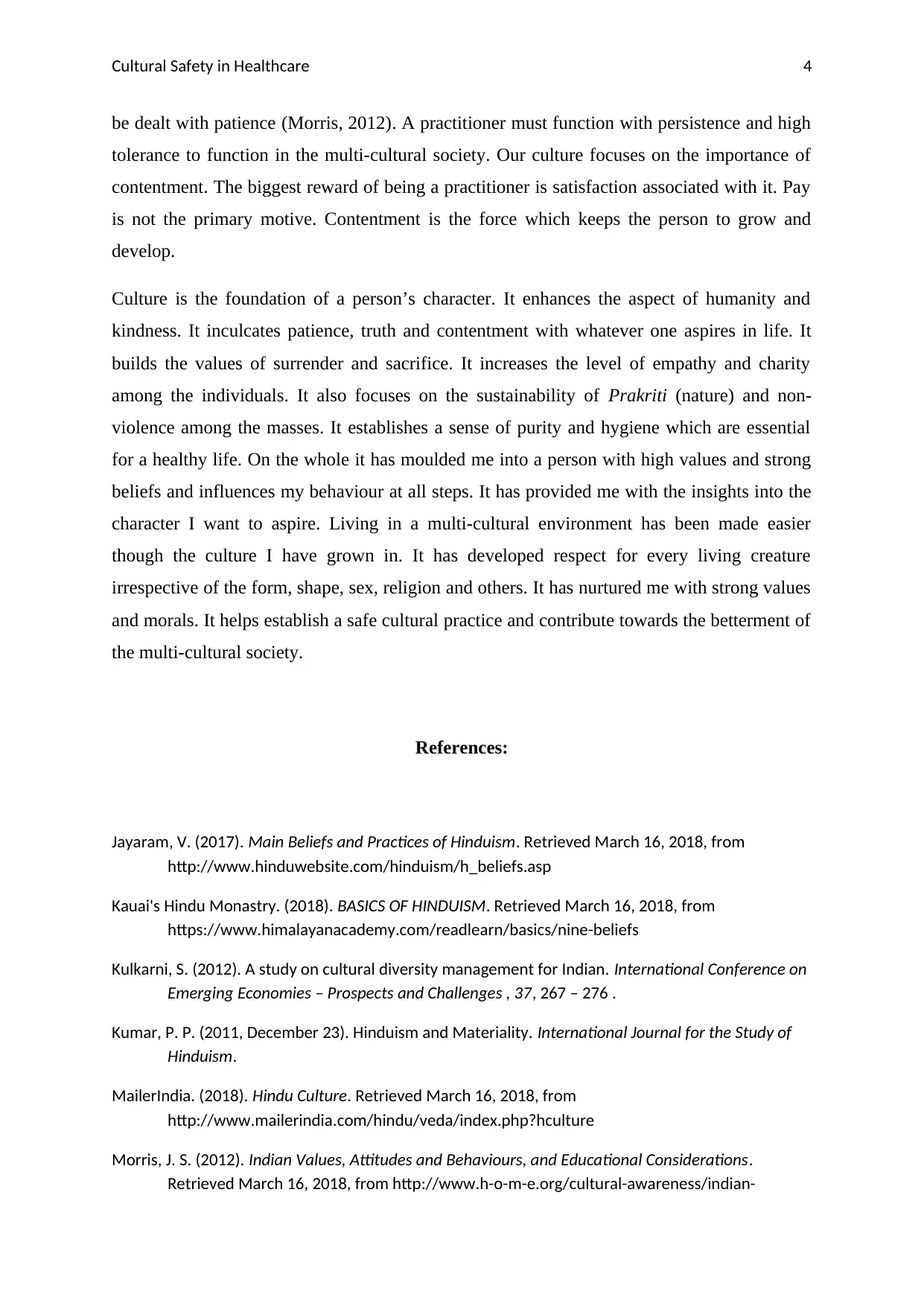
Cultural Safety in Healthcare 4
be dealt with patience (Morris, 2012). A practitioner must function with persistence and high
tolerance to function in the multi-cultural society. Our culture focuses on the importance of
contentment. The biggest reward of being a practitioner is satisfaction associated with it. Pay
is not the primary motive. Contentment is the force which keeps the person to grow and
develop.
Culture is the foundation of a person’s character. It enhances the aspect of humanity and
kindness. It inculcates patience, truth and contentment with whatever one aspires in life. It
builds the values of surrender and sacrifice. It increases the level of empathy and charity
among the individuals. It also focuses on the sustainability of Prakriti (nature) and non-
violence among the masses. It establishes a sense of purity and hygiene which are essential
for a healthy life. On the whole it has moulded me into a person with high values and strong
beliefs and influences my behaviour at all steps. It has provided me with the insights into the
character I want to aspire. Living in a multi-cultural environment has been made easier
though the culture I have grown in. It has developed respect for every living creature
irrespective of the form, shape, sex, religion and others. It has nurtured me with strong values
and morals. It helps establish a safe cultural practice and contribute towards the betterment of
the multi-cultural society.
References:
Jayaram, V. (2017). Main Beliefs and Practices of Hinduism. Retrieved March 16, 2018, from
http://www.hinduwebsite.com/hinduism/h_beliefs.asp
Kauai's Hindu Monastry. (2018). BASICS OF HINDUISM. Retrieved March 16, 2018, from
https://www.himalayanacademy.com/readlearn/basics/nine-beliefs
Kulkarni, S. (2012). A study on cultural diversity management for Indian. International Conference on
Emerging Economies – Prospects and Challenges , 37, 267 – 276 .
Kumar, P. P. (2011, December 23). Hinduism and Materiality. International Journal for the Study of
Hinduism.
MailerIndia. (2018). Hindu Culture. Retrieved March 16, 2018, from
http://www.mailerindia.com/hindu/veda/index.php?hculture
Morris, J. S. (2012). Indian Values, Attitudes and Behaviours, and Educational Considerations.
Retrieved March 16, 2018, from http://www.h-o-m-e.org/cultural-awareness/indian-
be dealt with patience (Morris, 2012). A practitioner must function with persistence and high
tolerance to function in the multi-cultural society. Our culture focuses on the importance of
contentment. The biggest reward of being a practitioner is satisfaction associated with it. Pay
is not the primary motive. Contentment is the force which keeps the person to grow and
develop.
Culture is the foundation of a person’s character. It enhances the aspect of humanity and
kindness. It inculcates patience, truth and contentment with whatever one aspires in life. It
builds the values of surrender and sacrifice. It increases the level of empathy and charity
among the individuals. It also focuses on the sustainability of Prakriti (nature) and non-
violence among the masses. It establishes a sense of purity and hygiene which are essential
for a healthy life. On the whole it has moulded me into a person with high values and strong
beliefs and influences my behaviour at all steps. It has provided me with the insights into the
character I want to aspire. Living in a multi-cultural environment has been made easier
though the culture I have grown in. It has developed respect for every living creature
irrespective of the form, shape, sex, religion and others. It has nurtured me with strong values
and morals. It helps establish a safe cultural practice and contribute towards the betterment of
the multi-cultural society.
References:
Jayaram, V. (2017). Main Beliefs and Practices of Hinduism. Retrieved March 16, 2018, from
http://www.hinduwebsite.com/hinduism/h_beliefs.asp
Kauai's Hindu Monastry. (2018). BASICS OF HINDUISM. Retrieved March 16, 2018, from
https://www.himalayanacademy.com/readlearn/basics/nine-beliefs
Kulkarni, S. (2012). A study on cultural diversity management for Indian. International Conference on
Emerging Economies – Prospects and Challenges , 37, 267 – 276 .
Kumar, P. P. (2011, December 23). Hinduism and Materiality. International Journal for the Study of
Hinduism.
MailerIndia. (2018). Hindu Culture. Retrieved March 16, 2018, from
http://www.mailerindia.com/hindu/veda/index.php?hculture
Morris, J. S. (2012). Indian Values, Attitudes and Behaviours, and Educational Considerations.
Retrieved March 16, 2018, from http://www.h-o-m-e.org/cultural-awareness/indian-
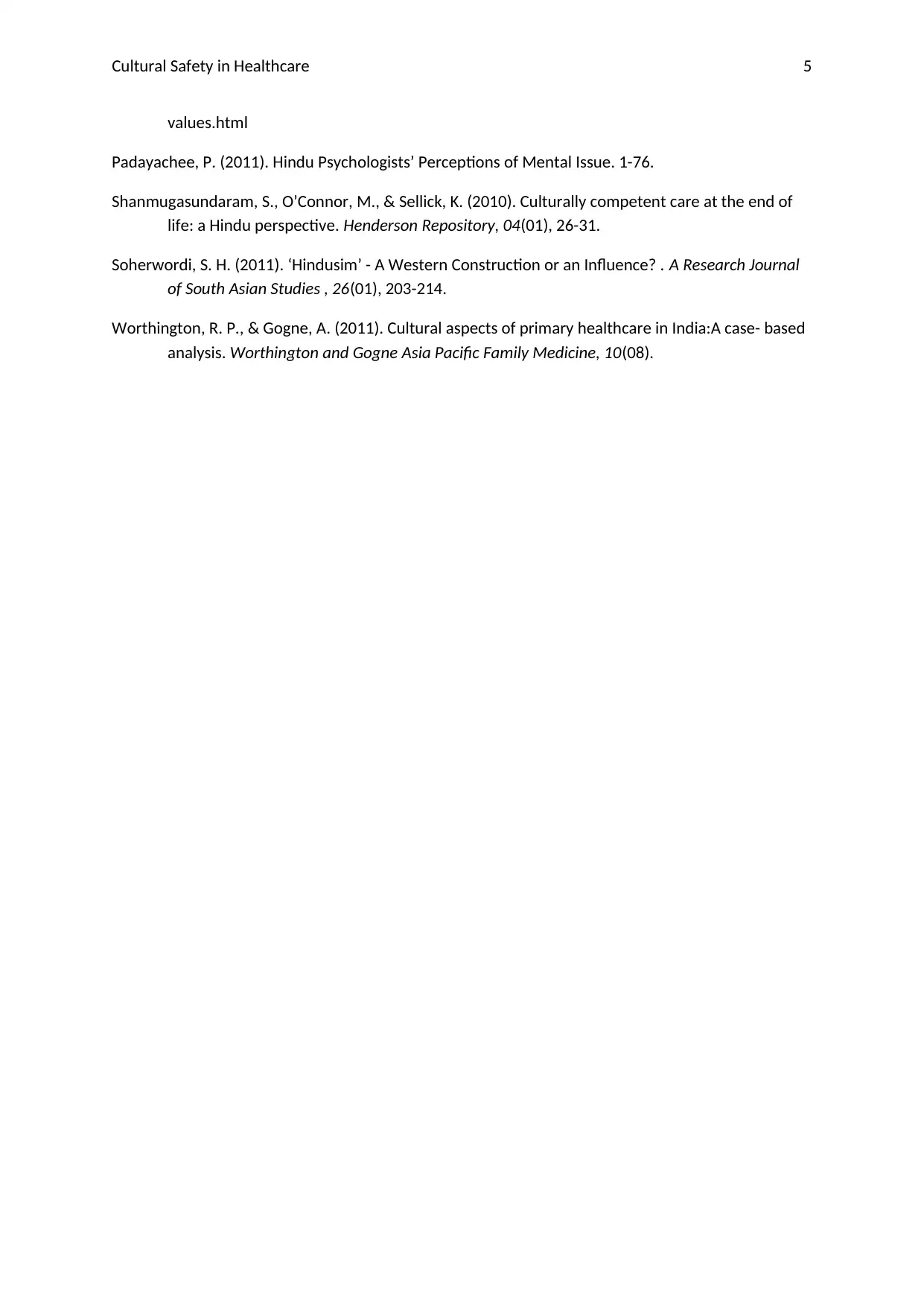
Cultural Safety in Healthcare 5
values.html
Padayachee, P. (2011). Hindu Psychologists’ Perceptions of Mental Issue. 1-76.
Shanmugasundaram, S., O’Connor, M., & Sellick, K. (2010). Culturally competent care at the end of
life: a Hindu perspective. Henderson Repository, 04(01), 26-31.
Soherwordi, S. H. (2011). ‘Hindusim’ - A Western Construction or an Influence? . A Research Journal
of South Asian Studies , 26(01), 203-214.
Worthington, R. P., & Gogne, A. (2011). Cultural aspects of primary healthcare in India:A case- based
analysis. Worthington and Gogne Asia Pacific Family Medicine, 10(08).
values.html
Padayachee, P. (2011). Hindu Psychologists’ Perceptions of Mental Issue. 1-76.
Shanmugasundaram, S., O’Connor, M., & Sellick, K. (2010). Culturally competent care at the end of
life: a Hindu perspective. Henderson Repository, 04(01), 26-31.
Soherwordi, S. H. (2011). ‘Hindusim’ - A Western Construction or an Influence? . A Research Journal
of South Asian Studies , 26(01), 203-214.
Worthington, R. P., & Gogne, A. (2011). Cultural aspects of primary healthcare in India:A case- based
analysis. Worthington and Gogne Asia Pacific Family Medicine, 10(08).
⊘ This is a preview!⊘
Do you want full access?
Subscribe today to unlock all pages.

Trusted by 1+ million students worldwide
1 out of 6
Related Documents
Your All-in-One AI-Powered Toolkit for Academic Success.
+13062052269
info@desklib.com
Available 24*7 on WhatsApp / Email
![[object Object]](/_next/static/media/star-bottom.7253800d.svg)
Unlock your academic potential
Copyright © 2020–2025 A2Z Services. All Rights Reserved. Developed and managed by ZUCOL.


